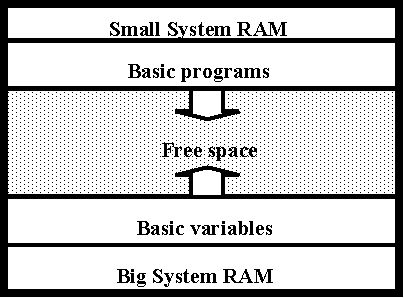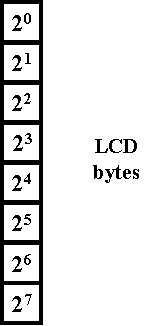The memory of PC-1403
Index
The program memory

- The program memory starts at 32768 and ends at 65535. The rest belongs to the system like display, interfaces and main program!
- The first
 BASIC line starts at 32817. You can move this position and move it back to have space for data. The memory locations 65281 and 65282 define this position: PEEK 65281+256* PEEK 65282 = start address. At this
BASIC line starts at 32817. You can move this position and move it back to have space for data. The memory locations 65281 and 65282 define this position: PEEK 65281+256* PEEK 65282 = start address. At this  address there must stand a
address there must stand a  byte with the value 255, after this the first line starts.
byte with the value 255, after this the first line starts.
- The end of the BASIC memory is marked with a 255, too. This address is given in the
 pointer at 65283 and 65284.
pointer at 65283 and 65284.
- Address of this end position = PEEK 65283+ 256* PEEK 65284
Line structure:
3  bytes (x,y,z), data bytes, Chr 13
bytes (x,y,z), data bytes, Chr 13
x,y: line number = x*256+y
z: Length of data block (Chr 13 counts, too!)
End of program marked with 255
A byte with the  ASCII code >= 128 in the data area of a line represents a BASIC command!
ASCII code >= 128 in the data area of a line represents a BASIC command!
A byte with the code 239 is a BASIC command, too. This command is defind by the following byte!
The pocket computer prints unknown commands as ~ .
Variable structure:
7 bytes (a,b,c,d,e,f,g), data
In the pointer PEEK 65287+256* PEEK 65288 the first address of the  variablen is defined.
variablen is defined.
Variables are written from behind, this means when you DIM a new variable it is written before the others and the start is moved to a smaller value. The start pointer points to the  header of the newest variable.
header of the newest variable.
Variables can be renamed using POKE. So you can write protect them (until CLEAR is used) poking an invalid name like Chr 32 or "!", etc.
Header structure:
7 bytes length
Example:
G$(5,5)*3
a: 71 = Variable name, here G
b: 160 =  String
String
c: 0 = HB of length of the complete variable
d: 111 = LB of length + 3 (because the rest of the header has 3 bytes)
e: 5 = Dim 5
f: 5 = , 5
g: 3 = * 3
DATA: 71 = 1. character of data
Meaning of the second header byte:
1-26 = String array, 2 character name with second character = Chr (Byte+64)
array, 2 character name with second character = Chr (Byte+64)
193-218 = Number array, 2 character name with second char = Chr (Byte-128)
129-154 = String, 2 character name [Chr (Byte-64)] variable (like NE$="test") always 16 bytes lengthy
65-90 = Number, 2 character name [Chr (Byte)] (like AA=0) always 8 byte lengthy
128: One character name number array
160: One character name string array
Data of a variable:
 Strings contain each character as a byte in
Strings contain each character as a byte in  ASCII code, Chr(0) is the end of a string. The Chr(0) is not used when the text is as long as the variable is dimensioned.
ASCII code, Chr(0) is the end of a string. The Chr(0) is not used when the text is as long as the variable is dimensioned.
Numbers are stored in the  BCD format. Each number needs 7 bytes.
BCD format. Each number needs 7 bytes.
In an  array the single variables are following without any divider character. The position of such a variable is calculated using the
array the single variables are following without any divider character. The position of such a variable is calculated using the  header data.
In a twodimensional array the arrays are following in a similar way: DIM B$(1,2)*1: B$(0,0) B$(0,1) B$(0,2) B$(1,0) B$(1,1) B$(1,2).
header data.
In a twodimensional array the arrays are following in a similar way: DIM B$(1,2)*1: B$(0,0) B$(0,1) B$(0,2) B$(1,0) B$(1,1) B$(1,2).
Access to the display:
The line with its 24 characters can be accessed using PEEK and POKE: When a BASIC program is running the display is switched off. You must use CALL 1208 to switch it on again to show your manipulations. The memory for the display has 5 bytes for each character. The first 7 bits are the 7 pixels height of each column. You can access the same display 256 bytes later, too!
 |
SHARP PC-1403H
|
1: 12288..12292
|
|
2: 12293..12297
|
|
3: 12298..12302
|
|
4: 12303..12307
|
|
5: 12308..12312
|
|
6: 12313..12317
|
|
7: 12333..12337
|
|
8: 12338..12342
|
|
9: 12343..12347
|
|
10: 12318..12322
|
|
11: 12323..12327
|
|
12: 12328..12332
|
|
13: 12396..12392 *
|
|
14: 12391..12387 *
|
|
15: 12386..12382 *
|
|
16: 12411..12407 *
|
|
17: 12406..12402 *
|
|
18: 12401..12397 *
|
|
19: 12381..12377 *
|
|
20: 12376..12372 *
|
|
21: 12371..12367 *
|
|
22: 12366..12362 *
|
|
23: 12361..12357 *
|
|
24: 12356..12352 *
|
*) These characters are accessed backwards!
|
The symbols SML, MATRIX, STAT and left and right from CAL and PRO are accessed in byte 12348 or 12604:
 Bit Bit | Symbol |
|---|
| 0 | ht (jap. symbols) |
| 1 | /|\ (jap. symbol) |
| 2 | SML |
| 3 | STAT |
| 4 | MATRIX |
| 5 | right from PRO |
| 6 | left from CAL |
| 7 | - |
The symbols BUSY, RUN, PRO, CAL, SHIFT, HYP, DEF are accessed in byte 12349 or 12605
 Bit Bit | Symbol |
|---|
| 0 | BUSY |
| 1 | DEF |
| 2 | SHIFT |
| 3 | HYP |
| 4 | PRO |
| 5 | RUN |
| 6 | CAL |
| 7 | - |
The symbols E, M, ( ), DE, G, RAD and PRINT are accessed in byte 12412 or 12668:
 Bit Bit | Symbol |
|---|
| 0 | E |
| 1 | M |
| 2 | ( ) |
| 3 | RAD |
| 4 | G |
| 5 | DE |
| 6 | PRINT |
| 7 | - |
System area:
| - | System variables (each 8  bytes long): bytes long):
| Var | Address | HB | LB |
|---|
| Z | 64272 | 251 | 16 |
| Y | 64280 | 251 | 24 |
| X | 64288 | 251 | 32 |
| W | 64296 | 251 | 40 |
| V | 64304 | 251 | 48 |
| U | 64312 | 251 | 56 |
| T | 64320 | 251 | 64 |
| S | 64328 | 251 | 72 |
| R | 64336 | 251 | 80 |
| Q | 64344 | 251 | 88 |
| P | 64352 | 251 | 96 |
| O | 64360 | 251 | 104 |
| N | 64368 | 251 | 112 |
| M | 64376 | 251 | 120 |
| L | 64384 | 251 | 128 |
| K | 64392 | 251 | 136 |
| J | 64400 | 251 | 144 |
| I | 64408 | 251 | 152 |
| H | 64416 | 251 | 160 |
| G | 64424 | 251 | 168 |
| F | 64432 | 251 | 176 |
| E | 64440 | 251 | 184 |
| D | 64448 | 251 | 192 |
| C | 64456 | 251 | 200 |
| B | 64464 | 251 | 208 |
| A | 64472 | 251 | 216 |
The first byte of each  variable is either CHR 245 when the variable is a variable is either CHR 245 when the variable is a  string or CHR 0 when it is a number. If the variable is shorter than 7 character, a Chr 0 marks the end! string or CHR 0 when it is a number. If the variable is shorter than 7 character, a Chr 0 marks the end!
|
| - | System addresses:
| LB | HB | Description |
|---|
| 65281 | 65282 | The BASIC start 255 |
| 65283 | 65284 | The BASIC end 255 |
| 65285 | 65286 | The last MERGEd block |
| 65287 | 65288 | The variable start |
| 65290 | bis 65296 | Password in ASCII code |
| 65367 | - | Input buffer: The last pressed key |
| 65299 | - | 2: WAIT on, 6: WAIT off |
| 65300 | - | 0-31: Password off, 32-63 Password on |
| 65312 | 65313 | Points after the last executed BASIC command |
| 65200 | bis 65279 | Input-/Output buffer 80 bytes |
| 65120 | bis 65143 | Display buffer in ASCII code |
| 65351 | 65352 | WAIT interval |
|
| - | The ROM:
The PC-1403 has a  ROM, which contains the operating system.
The ROM of the ROM, which contains the operating system.
The ROM of the  CPU is always at &0000 to &1FFF, the rest is banked in &4000 to &7FFF.
If you know system CALLs, you can improve your programs! CPU is always at &0000 to &1FFF, the rest is banked in &4000 to &7FFF.
If you know system CALLs, you can improve your programs!
CALL addresses
| Address | Description |
|---|
| 1208 | Switch the display on: Shows manipulations immediately. |
| 1226 | Switch computer off (use BRK/ON to switch it on!) |
| 1200 | Short BEEP |
| 1248 | Chirps |
|
Copyright © Simon Lehmayr (Parts of my page were made with the help of Laurent Duveau)
If this page has no navigation, click here.
Impressum
 BASIC line starts at 32817. You can move this position and move it back to have space for data. The memory locations 65281 and 65282 define this position: PEEK 65281+256* PEEK 65282 = start address. At this
BASIC line starts at 32817. You can move this position and move it back to have space for data. The memory locations 65281 and 65282 define this position: PEEK 65281+256* PEEK 65282 = start address. At this  address there must stand a
address there must stand a  byte with the value 255, after this the first line starts.
byte with the value 255, after this the first line starts. pointer at 65283 and 65284.
pointer at 65283 and 65284.

 Bit
Bit